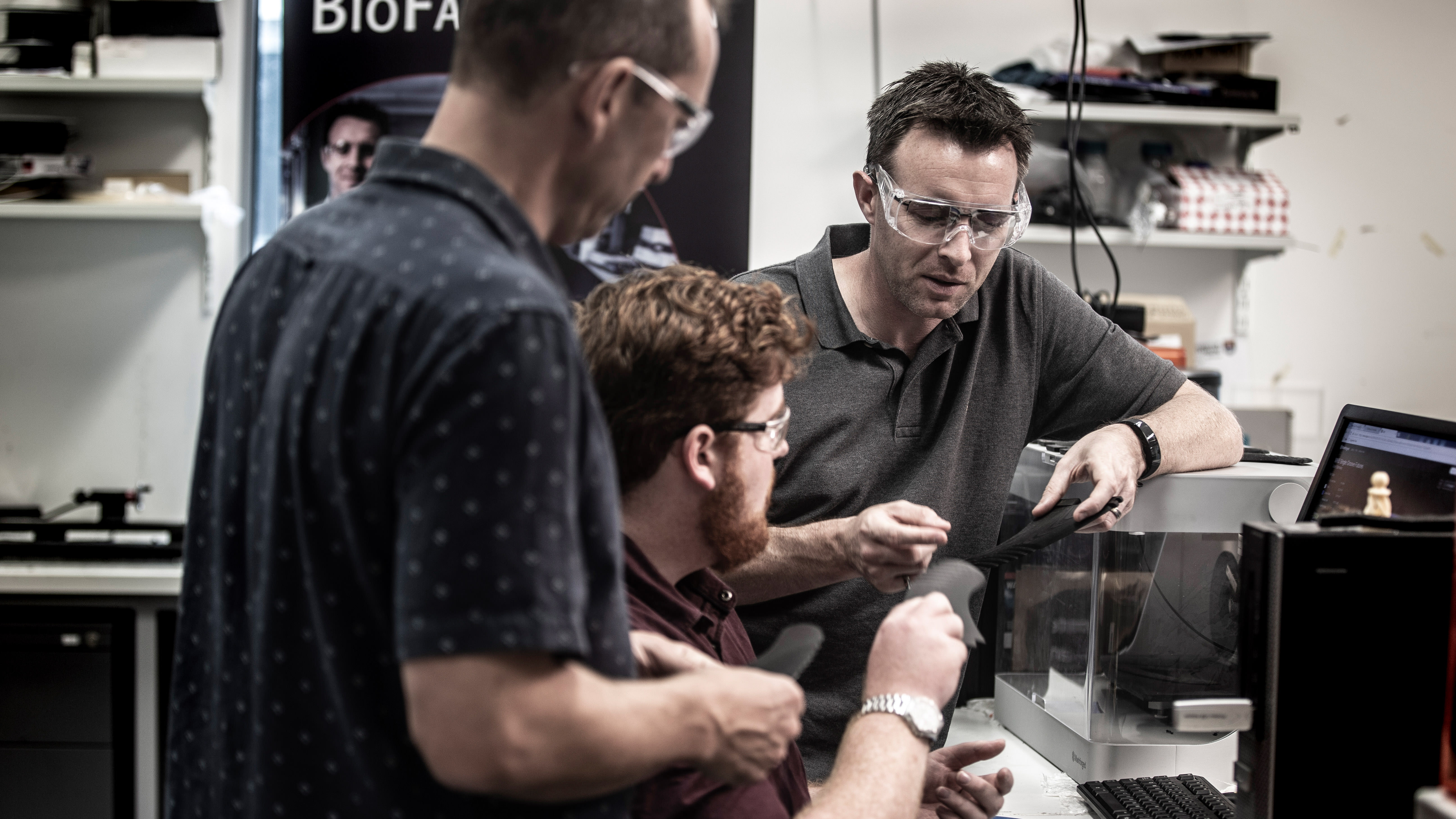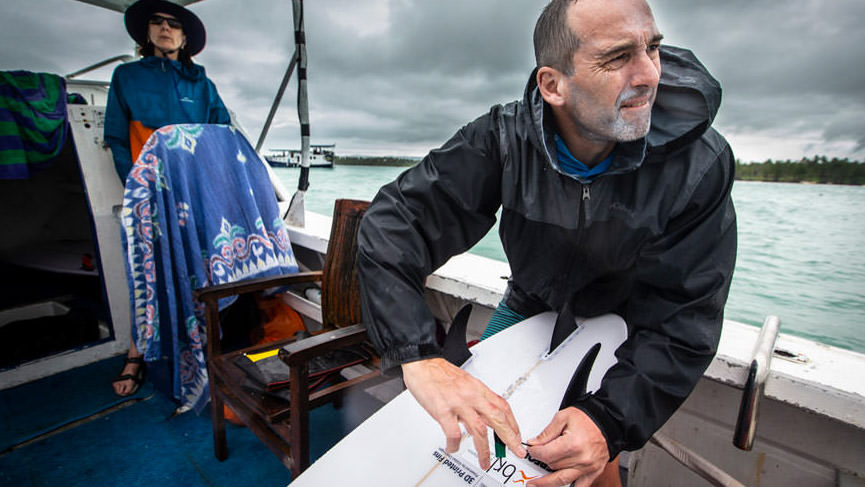Subscribe to The Stand
Want more UOW feature stories delivered to your inbox?
There is no such thing as a simple surfboard fin
July 24, 2018
Ever dreamed of surfing some of the world’s best surf breaks all in the name of research? That was the task for researchers from the University of Wollongong on a project to test the performance of 3D-printed surfboard fins.
To the untrained eye, the new 3D-printed surfboard fins look very similar to conventional surf fins, but according to Professor Marc in het Panhuis, an expert in additive manufacturing (3D printing) in the School of Chemistry at the University of Wollongong (UOW), the proof is in the ride.
Professor in het Panhuis from the Mentawai Islands, off the coast of West Sumatra, Indonesia, where a team of surfers and academics set out to combine surf and research. The mission for the team was to test a range of new UOW-designed 3D-printed surfboard fins and compare them with commercially available surf fins.
The project, part of UOW's Global Challenges Program, brought together a team of multidisciplinary researchers, as well as experienced surfers from the Illawarra, to see whether they could create a new niche manufacturing industry out of 3D-printed surfboard fins.
Professor in het Panhuis says surfers rely heavily on two things to ride waves; ocean swell and their board (fitted with fins). Surfboards come in a range of sizes and shapes, but when it comes to surfboard fins, the surfer can be rather blasé.
"There is no such thing as a simple surfboard fin," explains Professor in het Panhuis, who has been working on 3D-printed surfboard fin designs for the past four years.
"The team has looked at things like different materials that can make the fin stronger, lighter and its ability to flex."
Sitting in an office with surfboards leaning against a desk and surf posters gracing the walls, Professor in het Panhuis proudly holds up a 3D-printed fin and points to the different sections.
"There is a lot to a simple surfboard fin, you have to consider the fin base, depth, rake (or sweep), foil, cant, toe and flex. Not to forget, the number of fins and their positioning on a surfboard."
Part of the research team, Dr Stephen Beirne of the Australian National Fabrication Facility based at UOW, explains that the 3D-printed surfboard fin project was perfect to trial rapid prototyping and fabrication methods using 3D printers.
3D printing enables us to print virtually anything we can imagine and that includes surfboard fins. - Dr Beirne
"3D printing enables us to print virtually anything we can imagine and that includes surfboard fins," Dr Beirne says. "Our team started out creating CAD-generated fin designs on a computer, then we took those designs and used computational fluid dynamics to see how the fin was likely to perform in the water.
"The last part of the process was to select the most appropriate materials to print the prototype."
Professor in het Panhuis says researching, designing and printing the fins was the easy part. The hardest part was finding a consistent ocean wave to test out the performance characteristics of each printed fin "in the real world". But after an extensive search for an ideal test venue, the team were off to the Mentawai Islands in Indonesia.

Dr Stephen Beirne (rear right) reviews fin designs with Grant Barnsley and Professor Marc in het Panhuis.
The chain of islands off the western coast of Sumatra is a mecca for surfers due to an array of different surf breaks and dependable waves.
The team choose a particular left-hand-breaking wave called Macaronis. The wave is well-known as the most consistent wave in the Mentawai Islands, breaking perfectly on large or small swells and rideable in almost any wind condition.
"This was no holiday. We tracked and counted our participants surfing more than 450 waves and performing more than 1700 turns in all types of weather conditions over six days, for up to eight hours per day." - Professor Julie Steele
"Macaronis is a unique surfing spot because the waves always break on a reef in the same spot. The waves also roll over a long distance and surfers can get a maximum of turns, which is perfect for collecting surfboard fin data," says Professor in het Panhuis.
The surfing team, consisting of highly skilled surfers from UOW and the Illawarra region, had the challenge of catching a variety of waves with the array of different surfboard fins, and then performing as many turns as they could per wave.
One of the surfing participants was local South Coast surfboard shaper, Dylan Perese of DP Surfboards. He produced standardised surfboards for the trip that were all the same shape, which was vital for the fin testing.
"My role in the trip was a bit of research and development as a surfboard shaper and a bit of curiosity to test out these new 3D-printed fins," says Perese. "As a surfboard shaper I believe fins have a huge impact on the feel, stability, drive and manoeuvrability of a surfboard. Fins can completely alter the way you experience surfing."
In order to compile data on fin and surfing performance, Professor in het Panhuis used a selection of wearable GPS tracking devices and embedded sensors in the surfboard.
"The devices tracked everything from wave count, speed, number of turns to the amount of rail engaged during turning (to name but a few of the parameters). The surfers also filled out a fin performance rating scale immediately after they completed riding each set of fins. The information is then used to compare the different sets of fins."
Professor Julie Steele, Director of the Biomechanics Research Laboratory at UOW, was on hand to oversee the human trials and to collect the fin performance rating data.
Fins have a huge impact on the feel, stability, drive and manoeuvrability of a surfboard. Fins can completely alter the way you experience surfing - Dylan Perese, surfboard shaper
With more than 35 years of running human trials, Professor Steele was able to ensure the fin testing was conducted to provide scientifically robust data, making sure the research had no bias toward particular fin designs.
"The surfers were always happy to go for a surf, but they weren't allowed to look under their boards. We needed to make sure they were 'blinded' to which type of fin they were using at a given time. To help this, we changed their fins for them, and they were always referred to with coded names," Professor Steele says.
"Even though we were in an exotic location, this was no holiday. We tracked and counted our participants surfing more than 450 waves and performing more than 1700 turns in all types of weather conditions over six days, for up to eight hours per day, rocking around in a tiny boat in big ocean swell."

Professor Marc in het Panhuis (right) fits a tracking device while Professor Julie Steele collects data.
The team of six skilled surfers (three goofy and three naturals) was carefully selected based on their ability to repeatedly perform consistent turns on the waves and to provide feedback about fin performance. During the trials they tested three different prototype fins that were 3D printed and compared their performance to that of commercially available products from two mainstream fin producers.
"Now that we are home, we are working our way through the mountains of data that we have collected, with the aim of publishing our findings as soon as we can," Professor in het Panhuis says.
Professor Steels says preliminary analysis of the fin performance rating data has revealed that the surfers, on average, have rated one of the 3D printed fins as feeling the best to surf on. "We were surprised that there was such a strong preference for this one fin, given the six surfers all had very different surfing styles."
The reason the 'crinkle cut' fin shape works so well is because the contours improve the way the water flows past it. - Professor Marc in het Panhuis
The preferred fin, nicknamed "the Crinkle Cut", has a series of groves on one side of the fin. "Think of a potato crisp, hence the name crinkle cut," Professor in het Panhuis says.
"The reason this fin shape works so well is because the contours improve the way the water flows past it. These contours ultimately give the surfer more speed. The fins also seemed to offer plenty of drive and projection out of turns."
The idea behind the Crinkle Cut fin is to increase lift to drag ratio. The contours work their way across the fin from the thinnest part of the leading edge to the thickest portion in the middle. This is known as the fin's foil. These small contours have a big impact on water flow under the board and help to propel the surfer along a wave.
Professor in het Panhuis believes the project has the potential to strengthen Australia's competitive edge in certain niche manufacturing industries.
"We have shown that we can combine science and surfing, and that we can use 3D printing to produce unique fin prototypes that surfers love to ride."